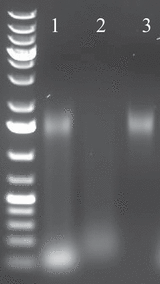STARR-seq and UMI-STARR-seq: Assessing Enhancer Activities for Genome-Wide-, High-, and Low-Complexity Candidate Libraries
- PMID: 31503413
- PMCID: PMC9286403
- DOI: 10.1002/cpmb.105
STARR-seq and UMI-STARR-seq: Assessing Enhancer Activities for Genome-Wide-, High-, and Low-Complexity Candidate Libraries
Abstract
The identification of transcriptional enhancers and the quantitative assessment of enhancer activities is essential to understanding how regulatory information for gene expression is encoded in animal and human genomes. Further, it is key to understanding how sequence variants affect enhancer function. STARR-seq enables the direct and quantitative assessment of enhancer activity for millions of candidate sequences of arbitrary length and origin in parallel, allowing the screening of entire genomes and the establishment of genome-wide enhancer activity maps. In STARR-seq, the candidate sequences are cloned downstream of the core promoter into a reporter gene's transcription unit (i.e., the 3' UTR). Candidates that function as active enhancers lead to the transcription of reporter mRNAs that harbor the candidates' sequences. This direct coupling of enhancer sequence and enhancer activity in cis enables the straightforward and efficient cloning of complex candidate libraries and the assessment of enhancer activities of millions of candidates in parallel by quantifying the reporter mRNAs by deep sequencing. This article describes how to create focused and genome-wide human STARR-seq libraries and how to perform STARR-seq screens in mammalian cells, and also describes a novel STARR-seq variant (UMI-STARR-seq) that allows the accurate counting of reporter mRNAs for STARR-seq libraries of low complexity. © 2019 The Authors. Basic Protocol 1: STARR-seq plasmid library cloning Basic Protocol 2: Mammalian STARR-seq screening protocol Alternate Protocol: UMI-STARR-seq screening protocol-unique molecular identifier integration Support Protocol: Transfection of human cells using the MaxCyte STX scalable transfection system.
Keywords: MPRA; STARR-seq; UMI-STARR-seq; cis-regulatory element; enhancer; functional genomics; gene expression; gene regulation; massively parallel reporter assay; transcriptional regulation.
© 2019 The Authors.
Figures



Similar articles
-
STARR-seq - principles and applications.Genomics. 2015 Sep;106(3):145-150. doi: 10.1016/j.ygeno.2015.06.001. Epub 2015 Jun 11. Genomics. 2015. PMID: 26072434 Review.
-
Functional assessment of human enhancer activities using whole-genome STARR-sequencing.Genome Biol. 2017 Nov 20;18(1):219. doi: 10.1186/s13059-017-1345-5. Genome Biol. 2017. PMID: 29151363 Free PMC article.
-
Genome-wide quantitative enhancer activity maps identified by STARR-seq.Science. 2013 Mar 1;339(6123):1074-7. doi: 10.1126/science.1232542. Epub 2013 Jan 17. Science. 2013. PMID: 23328393
-
HDI-STARR-seq: Condition-specific enhancer discovery in mouse liver in vivo.Res Sq [Preprint]. 2024 Jun 26:rs.3.rs-4559581. doi: 10.21203/rs.3.rs-4559581/v1. Res Sq. 2024. Update in: BMC Genomics. 2024 Dec 24;25(1):1240. doi: 10.1186/s12864-024-11162-9. PMID: 38978599 Free PMC article. Updated. Preprint.
-
Principle and application of self-transcribing active regulatory region sequencing in enhancer discovery research.Yi Chuan. 2024 Aug;46(8):589-602. doi: 10.16288/j.yczz.24-149. Yi Chuan. 2024. PMID: 39140141 Review.
Cited by
-
Next-generation plasmids for transgenesis in zebrafish and beyond.Development. 2023 Apr 15;150(8):dev201531. doi: 10.1242/dev.201531. Epub 2023 Apr 19. Development. 2023. PMID: 36975217 Free PMC article.
-
Advances in computational and experimental approaches for deciphering transcriptional regulatory networks: Understanding the roles of cis-regulatory elements is essential, and recent research utilizing MPRAs, STARR-seq, CRISPR-Cas9, and machine learning has yielded valuable insights.Bioessays. 2024 Jul;46(7):e2300210. doi: 10.1002/bies.202300210. Epub 2024 May 8. Bioessays. 2024. PMID: 38715516 Free PMC article. Review.
-
Precise engineering of gene expression by editing plasticity.Genome Biol. 2025 Mar 10;26(1):51. doi: 10.1186/s13059-025-03516-7. Genome Biol. 2025. PMID: 40065399 Free PMC article.
-
Enhancer-gene specificity in development and disease.Development. 2022 Jun 1;149(11):dev186536. doi: 10.1242/dev.186536. Epub 2022 Jun 10. Development. 2022. PMID: 35686641 Free PMC article. Review.
-
Widespread position-dependent transcriptional regulatory sequences in plants.Nat Genet. 2024 Oct;56(10):2238-2246. doi: 10.1038/s41588-024-01907-3. Epub 2024 Sep 12. Nat Genet. 2024. PMID: 39266765 Free PMC article.
References
Literature Cited
Key Reference
-
- Muerdter et al. (2018). See above.
Publication types
MeSH terms
LinkOut - more resources
Full Text Sources
Research Materials

